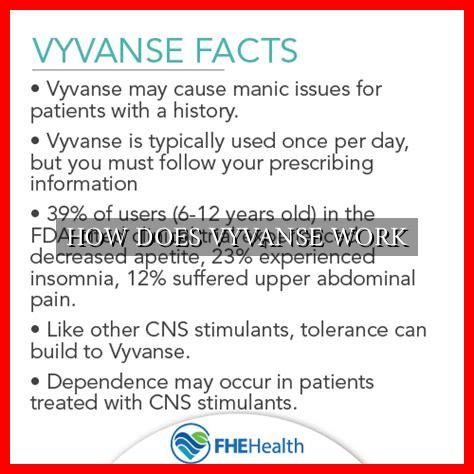-
Table of Contents
How Does Vyvanse Work
Vyvanse is a prescription medication commonly used to treat attention deficit hyperactivity disorder (ADHD) in both children and adults. It is a central nervous system stimulant that works by affecting certain chemicals in the brain that contribute to hyperactivity and impulse control. Understanding how Vyvanse works can provide valuable insights into its mechanism of action and effectiveness in managing ADHD symptoms.
Mechanism of Action
Vyvanse contains the active ingredient lisdexamfetamine, which is a prodrug that is converted into dextroamphetamine in the body. Dextroamphetamine is a potent stimulant that increases the levels of neurotransmitters such as dopamine and norepinephrine in the brain. These neurotransmitters play a crucial role in regulating attention, focus, and impulse control.
Dopamine
Dopamine is a neurotransmitter that is involved in the brain’s reward system and plays a key role in motivation, pleasure, and reinforcement.
. By increasing dopamine levels, Vyvanse can help improve attention and focus, as well as reduce impulsivity and hyperactivity in individuals with ADHD.
Norepinephrine
Norepinephrine is another neurotransmitter that is involved in the body’s fight-or-flight response. By increasing norepinephrine levels, Vyvanse can enhance alertness, concentration, and cognitive function, which are often impaired in individuals with ADHD.
Effects on ADHD Symptoms
By increasing the levels of dopamine and norepinephrine in the brain, Vyvanse can help improve the following symptoms of ADHD:
- Difficulty paying attention
- Impulsivity
- Hyperactivity
- Disorganization
Studies have shown that Vyvanse is effective in reducing these symptoms and improving overall functioning in individuals with ADHD. It can help increase focus, attention span, and impulse control, allowing individuals to better manage their daily tasks and responsibilities.
Duration of Action
Vyvanse is an extended-release medication that provides a gradual and sustained release of dextroamphetamine throughout the day. This allows for a smoother onset of action and a longer duration of effect compared to immediate-release stimulants. The effects of Vyvanse typically last for up to 12 hours, providing consistent symptom relief throughout the day.
Side Effects
While Vyvanse is generally well-tolerated, it can cause side effects in some individuals. Common side effects of Vyvanse may include:
- Insomnia
- Loss of appetite
- Headache
- Stomach upset
It is important to discuss any side effects with your healthcare provider to determine the best course of action. In some cases, dosage adjustments or alternative medications may be recommended to minimize side effects.
Conclusion
In conclusion, Vyvanse works by increasing the levels of dopamine and norepinephrine in the brain, which helps improve attention, focus, and impulse control in individuals with ADHD. Its extended-release formulation provides consistent symptom relief throughout the day, making it a popular choice for managing ADHD symptoms. Understanding how Vyvanse works can help individuals and healthcare providers make informed decisions about its use in treating ADHD.



